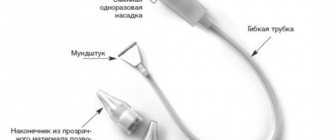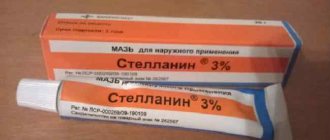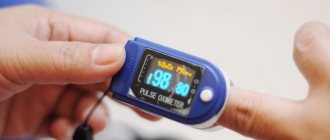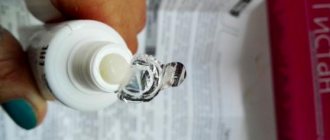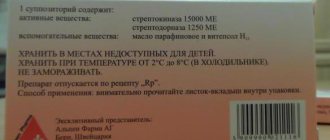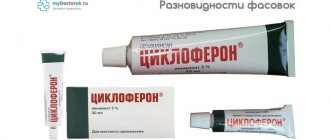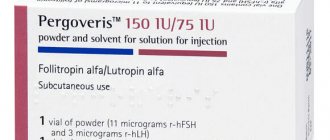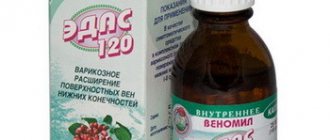Olazol is a complex drug with antibacterial and analgesic properties. It promotes rapid regeneration of damaged tissues. It is used in the treatment of burns, ulcers, wounds, dermatitis, and eczema. Already in the first few hours after the first application, pain and burning decrease, as well as the amount of exudate flowing from the wound, and it begins to heal. Before using the drug Olazol for the first time, you must read the instructions. It provides information on the method of use, as well as contraindications and side effects. It is recommended to use the medicine after consultation with your doctor.
Olazol is a universal drug that is applied to the skin to destroy harmful bacteria. It is used exclusively externally using a special spray nozzle. Positive effects are achieved through regular application to the affected area. Olazol spray anesthetizes locally and kills a large number of harmful bacteria.
…
Composition, release form
The medication can be found on pharmacy shelves in the form of a spray or aerosol for external use if the need arises. A spray is a liquid in a spray bottle. Each bottle contains 60, 80 or 120 ml.
The sprayer helps to distribute the product on the skin and is easy to use. Each bottle of solution is placed in a small cardboard box and is accompanied by a description detailing all the features of the therapy, possible contraindications and complications.
The medicine contains several active ingredients that provide the main effect:
- Chloramphenicol.
- Benzocaine.
- Boric acid.
- Sea buckthorn oil.
- Levomycetin.
These ingredients provide a complex effect on the body. As an auxiliary ingredient, the composition contains anesthesin, anhydrous lanolin, and triethanolamine.
The composition contains an emulsion base, which ensures the correct consistency of the product. Auxiliary ingredients do not have therapeutic properties, unless you take into account anesthesin, which has analgesic properties.
Overdose
External use of the drug in recommended doses does not cause an overdose.
Long-term and frequent use of drugs containing chloramphenicol can lead to contact sensitization, which is accompanied by the development of hypersensitivity reactions with subsequent use of the drug externally or in dosage forms for systemic use.
Symptoms of overdose during systemic absorption of benzocaine may include: drowsiness, anxiety, cardiac arrhythmias, and agitation. In severe cases - convulsions, coma, decreased respiratory rate or respiratory failure. There are reports that the use of products containing benzocaine has caused methemoglobinemia. Symptoms such as cyanosis of the skin, lips and nail beds, headache, dizziness, shortness of breath (difficulty breathing), weakness, tachycardia, which may occur during treatment, may indicate methemoglobinemia, which is potentially life-threatening and requires urgent medical attention. Emergency treatment for overdose and the development of methemoglobinemia consists of intravenous administration of methylene blue.
Symptoms of overdose with systemic absorption of boric acid may include: nausea, vomiting, diarrhea, circulatory disorders and depression of the central nervous system, decreased body temperature, shock, coma, and erythematous rash. In case of severe poisoning, measures are taken to maintain the vital functions of the body, hemodialysis or peritoneal dialysis, and replacement blood transfusion are performed. With prolonged use of the drug over large areas of skin, symptoms of chronic intoxication may occur: tissue swelling, exhaustion, stomatitis, eczema, menstrual irregularities in women, anemia, convulsions, alopecia.
Symptoms of overdose require discontinuation of the drug and symptomatic treatment.
How the spray works and its effectiveness
Olazol is a spray for burns and symptoms of other dermatological diseases, which has local analgesic and anti-inflammatory properties. The product eliminates tissue swelling, helps destroy bacteria and prevents the development of complications against the background of the rapid progression of diseases.
When the product is applied to the skin, symptoms are quickly eliminated, and the appearance of associated abnormalities is also prevented.
Another effect of the aerosol on fabric is noted:
- The drug stimulates tissue restoration. The presence of sea buckthorn oil helps improve the nutrition of skin cells and accelerates cell regeneration processes. This helps not only to shorten the recovery period, but also has a positive effect on your overall condition.
- Clears tissues of purulent masses in case of development of a purulent inflammatory process. In this case, the product quickly penetrates into all areas of the lesion, destroys bacteria, prevents their reproduction and spread to healthy tissue. These are considered the most important properties of the aerosol, as they reduce the risk of developing other complications as the disease progresses.
- The product has pronounced analgesic properties. This helps to significantly alleviate the condition in patients who suffer from systemic disorders against the background of acute local reactions. After eliminating the pain, there is a gradual disappearance of systemic disorders in the form of weakness and fatigue, and increased body temperature.
- Slows down the process of protein exudate secretion from the skin, which improves the condition of tissues and prevents weeping of wounds and burns.
- Eliminates tissue swelling observed with burns and other skin disorders.
- It has antibacterial properties, which is considered most important in the fight against purulent inflammation. The drug is active against many bacteria that provoke the inflammatory process.
Olazol spray
When an aerosol is applied to the skin, it quickly penetrates the outer layers and provides a therapeutic effect. The drug is considered effective, even when used in advanced stages of the pathological condition.
The medicine is absorbed into the systemic bloodstream in small quantities, which makes it less dangerous with prolonged use over large areas of the skin. Despite this, a small concentration of the ingredients is detected in blood tests. The components of the composition are processed in the patient’s liver and excreted from the body through the kidneys.
If the functioning of internal organs is disrupted, there is a deterioration in the process of processing and removing ingredients from the body. There is no accumulation of substances during prolonged use, and there is no effect on the functioning of internal organs and systems.
Pharmacological properties
Pharmacodynamics.
A combined drug that has an anesthetic, antibacterial (shows activity against many gram-positive and gram-negative bacteria, pus-forming microbes, hemophilus bacteria, Brucella, rickettsia, chlamydia, spirochetes) and anti-inflammatory effects, reduces exudation, promotes tissue regeneration and accelerates the process of epithelization of wounds.
Pharmacokinetics.
Data not provided. The drug has some degree of systemic action.
Clinical characteristics.
Features of application
Olazol is prescribed not only to relieve the symptoms of burns.
The spray is often used for other disorders:
- Trophic ulcers on the legs, which arise as a result of the progression of thrombophlebitis, varicose veins. Patients with such diseases often experience inflammation due to infection in the area of damaged skin. Disorders arise as a result of deterioration or complete absence of trophism of the tissues of the legs.
- Burns of varying degrees. The drug can be used in the presence or absence of complications in the burn area.
- Infected wounds, abrasions and cracks. In this case, the medicine can be used in the presence of long-term non-healing wounds in different areas of the skin.
- Eczema of microbial origin. The medicine alleviates acute symptoms, prevents the spread of the lesion to large areas of the skin.
- Dermatitis with severe itching of the skin. The drug helps eliminate acute symptoms and prevents infection in case of tissue damage during scratching.
The drug can be used when lesions appear against the background of systemic disorders or circulatory disorders.
Despite the effectiveness and relative safety of the drug, it has contraindications. An absolute obstacle to therapy is considered to be intolerance to the components of the composition or a tendency to such manifestations in the patient's medical history. However, there are relative contraindications that should be taken into account before starting treatment.
The drug is used with caution for the treatment of patients during lactation and pregnancy. Despite the minimal absorption of the ingredients of the composition into the blood, it can cause complications when used without a doctor’s prescription. That is why, when symptoms appear, you should first visit a specialist who will determine the advisability of using the spray.
Do not use the medicine if the patient has a history of acute liver and kidney pathologies. Only in some cases, when acute symptoms appear, is it permissible to use the medicine in short courses as prescribed by a doctor. In pediatrics, the spray is not used so often, but if an urgent need arises, it is allowed to apply the spray to the skin of patients over 2 years of age.
In this case, the child’s treatment should be carried out under strict supervision. The doctor evaluates the result of therapy, extends it or cancels it. Relative contraindications include fungal pathologies of the skin. The aerosol is prescribed only when acute skin symptoms appear due to burns or the development of a purulent process.
Contraindications
Hypersensitivity to any component of the drug, including excipients. Increased individual sensitivity to other amide local anesthetics. History of allergy and toxic reaction (dyspeptic symptoms, dysbiosis, mental disorders) to chloramphenicol. Psoriasis, eczema, fungal skin diseases, suppression of bone marrow hematopoiesis, thromboembolic disease, granulocytopenia, periods of pregnancy or lactation. Renal dysfunction. Children under 2 years of age.
Interaction with other drugs and other types of interactions.
Do not use simultaneously with other antimicrobial agents for local (intravaginal) use.
Simultaneous use with erythromycin, oleandomycin, nystatin and levorin increases the antibacterial activity of the drug, and with benzylpenicillin salts it decreases. It should not be prescribed simultaneously with drugs that inhibit hematopoiesis (sulfonamides, pyrazolone derivatives, cytostatics), with biphenyl, barbiturates, ethanol.
It is not recommended to use the drug without clear medical indications and medical supervision while regularly taking monoamine oxidase inhibitors (MAOIs), antidepressants and antihypertensive drugs due to the theoretical possibility of reducing the effect of MAO inhibitors or enhancing the effect of antihypertensive drugs due to interaction with benzocaine in cases of significantly exceeding recommended doses and duration of treatment.
How to take it correctly
Olazol is a spray for burns, which is usually used according to a standard therapeutic regimen and for the time prescribed by a specialist. The treatment regimen and dosage are determined depending on the patient’s age, as well as the characteristics of the course of the skin disease.
| Patient age | Features of using the product |
| Children 2-7 years old | For such patients, the product is applied in a very thin layer to the affected area. It is usually recommended to treat the skin no more than once a day. When spraying the solution, the distance from the tip of the nozzle to the tissues should be at least 1 and no more than 5 cm. After distribution, the product is left on the skin for 40-60 minutes, depending on the severity of local reactions. Sometimes doctors allow you to leave the product on the skin until it dries completely. The duration of the therapeutic course is 5-10 days. If a child has a long-term non-healing wound on the skin, it will take more time to obtain a therapeutic result. |
| Patients from 7 to 12 years old | Such patients are treated no more than 2 times a day. When processing, a thin layer is required to be applied using a special sprayer to the entire affected surface of the skin. After application, you can leave the drug on the skin or remove it after 1 hour of exposure. Experts note that the best effect is achieved when used for 1-2 weeks. If there is no result, it is possible to use other agents with more pronounced properties. |
| Patients from 12 to 18 years old | For patients of this age, the use is prescribed in courses of 1-2 weeks. In each case, the specific duration is determined individually depending on the severity of the manifestations. The product is applied no more than 3 times a day in a thin layer, controlling the amount of solution applied. It is allowed to remove the product from the surface of a burn or wound after 1-2 hours, but this is not considered a prerequisite. |
| Adults | For adults, treatment is carried out no more than 4 times a day; the solution is applied using a sprayer in a thin layer at a distance of 1-5 cm from the lesion. Application is continued for 5-14 days, which depends on the symptoms of the skin. |
After distributing the solution on the skin, a white or almost white foam forms. It promotes the penetration of components into the outer layers of the skin, which provides a pronounced therapeutic effect.
The use of the medicine must be agreed with the doctor, while the specialist at different stages evaluates the effectiveness of therapy, adjusts the number of applications per day and duration.
special instructions
Olazol is a spray for burns, which can be used in the presence of trophic wounds in the affected area. Often, specialists do not allow the prescription of local remedies if there are trophic ulcers in the burn area.
When applying, it is important to avoid getting the product into the eyes, mouth, and nasal passages. This can provoke complications, allergic manifestations and other tissue reactions. If the patient does not feel relief within 3 days after starting therapy, it is necessary to consult a doctor. Perhaps the remedy is not suitable for the person and another medicine with similar properties needs to be prescribed.
During the therapy period, you should avoid using other medications containing the same components. Topical application of such agents at the same time can lead to severe adverse reactions.
Precautionary measures
When treating with the drug, it is important to follow all recommendations. Negative reactions often develop, affecting not only the area of treatment, but also the functioning of internal organs.
The most common complications:
- A rash on the skin, accompanied by itching, burning, and peeling of the skin.
- Weakness and fatigue, decreased performance, deterioration of concentration and memory.
- Watery eyes, swelling of the mucous membranes of the eyelids and itching. If symptoms persist for a long time, there is difficulty blinking, as well as deterioration in the quality of vision.
- Loss of appetite and upset stool, pain in the abdomen.
- Some patients report nausea and vomiting.
- Deterioration in the functioning of internal organs, such as the liver and kidneys. Such symptoms appear especially often in patients with chronic diseases of these organs.
Negative reactions significantly worsen the condition of patients. Doctors pay attention to the fact that systemic reactions occur against the background of local negative manifestations.
That is why eliminating allergic symptoms helps to get rid of accompanying abnormalities. You should not ignore the symptoms or use any medications yourself to eliminate them. It is recommended to visit a doctor who will prescribe medications suitable for a particular patient.
The medicine does not provoke an overdose, even with prolonged use. But this is not considered a reason to apply in large doses without a doctor’s prescription.
Side effects
Local reactions:
slight temporary (2–3 min) increase in discomfort in the anal area after administration of the drug.
From the immune system:
allergic reactions are possible, including angioedema, other signs of irritation that were not noted before treatment, skin rashes, itching, burning sensation, hyperemia, swelling. Long-term external use often leads to contact sensitization.
From the gastrointestinal tract:
possible urge to defecate, dyspepsia (nausea, vomiting, loose stools). In these cases, the use of the drug should be discontinued.
From the hematopoietic system:
leukopenia, thrombocytopenia, reticulocytopenia, decreased hemoglobin levels in the blood.
Analogs
Olazol is a spray for burns that has no analogues that contain the same components in the composition. But if necessary, you can select products with similar properties.
Most often the drug is replaced with the following medications:
- Solcoseryl – a gel for external use, which contains an extract from the blood of young calves and has pronounced regenerating properties. The drug is used to accelerate wound healing and prevent the progression of the inflammatory process. But the gel does not have analgesic or antibacterial properties. Its price starts from 170 rubles.
- Levomekol has pronounced antibacterial properties and is used when purulent, infected wounds of varying degrees of neglect appear. The drug helps cleanse tissues of microbes and prevents their spread to healthy areas of the skin. The ointment is one of the most affordable analogues, costs approximately 50-70 rubles.
- D-panthenol is also available in the form of cream and spray, has regenerating and softening properties, and can be used for mild burns and some types of irritation. The cost of the product ranges from 150-340 rubles. depending on the form of release and its quantity in the package.
The substitute in each case is selected by the doctor depending on the specific symptoms of the pathological condition. You cannot use analogues yourself, as this can provoke serious complications.
Olazol is a popular spray that is used to relieve the symptoms of burns, infected wounds, and trophic ulcers. The product is effective, but use is allowed only after examination and identification of the severity of the pathology.

